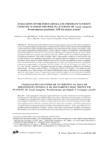Por favor, use este identificador para citar o enlazar este ítem:
http://www.alice.cnptia.embrapa.br/alice/handle/doc/339244Registro completo de metadatos
| Campo DC | Valor | Lengua/Idioma |
|---|---|---|
| dc.contributor.author | BALIEIRO, F. de C. | pt_BR |
| dc.contributor.author | FRANCO, A. A. | pt_BR |
| dc.contributor.author | FONTES, R. L. F. | pt_BR |
| dc.contributor.author | DIAS, L. E. | pt_BR |
| dc.contributor.author | CAMPELLO, E. F. C. | pt_BR |
| dc.contributor.author | FARIA, S. M. de | pt_BR |
| dc.date.accessioned | 2016-10-06T22:35:41Z | - |
| dc.date.available | 2016-10-06T22:35:41Z | - |
| dc.date.created | 2008-01-16 | pt_BR |
| dc.date.issued | 2007 | pt_BR |
| dc.identifier.citation | Revista Árvore, Viçosa, MG, v. 31, n. 2, p. 339-346, mar./abr. 2007. | pt_BR |
| dc.identifier.uri | http://www.alice.cnptia.embrapa.br/alice/handle/doc/339244 | pt_BR |
| dc.description | The interception of the rainfall by the forest canopy has great relevance to the nutrient geochemistry cycle in low fertility tropical soils under native or cultivated forests. However, little is known about the modification of the rainfall water quality and hydrological balance after interception by the canopies of eucalyptus under pure and mixed plantations with leguminous species, in Brazil. Samples of rainfall (RF), throughfall (TF) and stemflow (SF) were collected and analyzed in pure plantations of mangium (nitrogen fixing tree -NFT), guachapele (NFT) and eucalyptus (non-nitrogen fixing tree -NNFT) and in a mixed stand of guachapele and eucalyptus in Seropédica, State of Rio de Janeiro, Brazil. Nine stemflow collectors (in selected trees) and nine pluviometers were randomly disposed under each stand and three pluviometers were used to measure the incident rainfall during 5.5 months. Mangium conveyed 33.4% of the total rainfall for its stem. An estimative based on corrections for the average annual precipitation (1213 mm) indicated that the rainfall's contribution to the nutrient input (kg ha-1) was about 8.42; 0.95; 19.04; 6.74; 4.72 and 8.71 kg ha-1 of N-NH4+, P, K+, Ca+2, Mg+2 and Na+, respectively. Throughfall provided the largest contributions compared to the stemflow nutrient input. The largest inputs of N-NH4+ (15.03 kg ha-1) and K+ (179.43 kg ha-1) were observed under the guachapele crown. Large amounts of Na+ denote a high influence of the sea. Mangium was the most adapted species to water competitiveness. Comparatively to pure stand of eucalyptus, the mixed plantation intensifies the N, Ca and Mg leaching by the canopy, while the inputs of K and P were lower under these plantations. A interceptação da chuva pela copa das florestas tem grande relevância no ciclo biogeoquímico de nutrientes nos solos de baixa fertilidade sob florestas nativas e plantadas. Entretanto, pouco se sabe sobre as modificações na qualidade dessa água e no balanço hidrológico após a interceptação pela copa do eucalipto sob condições de plantios puros e mistos com leguminosas, no Brasil. Amostras de água de chuva (RF), de precipitação interna (TF) e de escoamento pelo tronco (SF), foram coletadas e analisadas quimicamente em plantios puros de mangium (espécie fixadora de nitrogênio atmosférico - EFN), guachapele (EFN) e eucalipto (espécie não fixadora de nitrogênio - ENFN) e consorciados com guachapele e eucalipto, em Seropédica, Rio de Janeiro. Nove coletores de escoamento pelo tronco (colocados em árvores), nove pluviômetros posicionados ao acaso nos plantios e três fora da influência deles foram utilizados no monitoramento durante 5,5 meses. A mangium direcionou 33,4% do total precipitado para o seu tronco. Uma estimativa baseada na correção da média anual precipitada na área (1.213 mm) indicou uma contribuição no aporte de nutrientes (kg ha-1) de 8,42; 0,95; 19,04; 6,74; 4,72; e 8,71 kg ha-1 dos elementos N-NH4+, P, K+, Ca+2, Mg+2 and Na+, respectivamente. A precipitação interna participou com a maior parte da contribuição, em comparação com o escoamento pelo tronco. Os maiores aportes de N-NH4+ (15,03 kg ha-1) e K+ (179,43 kg ha-1) foram observados sob as copas de guachapele em plantio puro. Elevada quantidade de Na+ denota influencia do mar próximo à área experimental. A mangium foi a espécie adaptada à competição por água. Comparativamente ao plantio puro de eucalipto, o plantio misto intensificou a lixiviação de N, Ca e Mg da copa, enquanto o de K e o P aportaram em menores quantidades nesse plantio. | pt_BR |
| dc.language.iso | eng | eng |
| dc.rights | openAccess | eng |
| dc.subject | Ciclagem de nutrientes | pt_BR |
| dc.subject | Leguminosas arbóreas | pt_BR |
| dc.subject | Aporte atmosférico de nutrientes | pt_BR |
| dc.subject | Plantio florestal misto | pt_BR |
| dc.title | Evaluation of the throughfall and stemflow nutrient contents in mixed and pure plantations of Acacia mangium, Pseudosamanea guachapele and Eucalyptus grandis. | pt_BR |
| dc.type | Artigo de periódico | pt_BR |
| dc.date.updated | 2016-10-06T22:35:41Z | pt_BR |
| riaa.ainfo.id | 339244 | pt_BR |
| riaa.ainfo.lastupdate | 2020-09-14 -03:00:00 | pt_BR |
| dc.identifier.doi | https://doi.org/10.1590/S0100-67622007000200017 | eng |
| dc.contributor.institution | FABIANO DE CARVALHO BALIEIRO, CNPS; AVILIO ANTONIO FRANCO, CNPAB; RENILDES LÚCIO FERREIRA FONTES, UFV; LUIZ EDUARDO DIAS, UFV; EDUARDO FRANCIA CARNEIRO CAMPELLO, CNPAB; SERGIO MIANA DE FARIA, CNPAB. | pt_BR |
| Aparece en las colecciones: | Artigo em periódico indexado (CNPS)  | |
Ficheros en este ítem:
| Fichero | Descripción | Tamaño | Formato | |
|---|---|---|---|---|
| a17v31n2.pdf | 375,33 kB | Adobe PDF |  Visualizar/Abrir |









